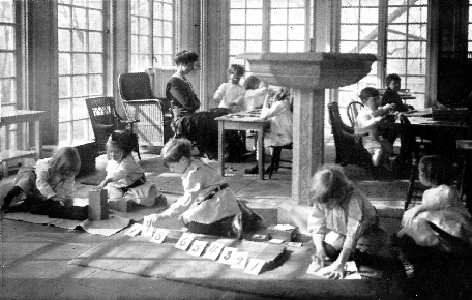Montessori Programs – Toddler, Preschool & Kindergarten in Temecula
Discover Montessori Education...
The Montessori method of education developed by Dr. Maria Montessori is a child-centered, developmentally based approach to education. The philosophy views the child as someone eager for knowledge who will initiate learning in a supportive, stimulating, and thoughtfully prepared learning environment. The Montessori approach values the development of the whole child – the physical, social, emotional, and cognitive development. Maria Montessori believed that finding one’s place in the world, finding work that is meaningful and fulfilling, and developing the inner peace and depth of soul that allows one to love are the most important goals in life. Today, Montessori schools throughout the world have as their foundation her deep respect for children as unique individuals and her profound concern for their social and emotional development.

Maria Montessori believed in children’s inherent desire to learn. Montessori classrooms include multi-age groupings which foster collaboration, and children may work in groups or on their own. The enticing materials invite hands-on exploration, and children move about the room as they find their best place to work. Real-life lessons provide authentic learning, uninterrupted blocks of work time encourage deep concentration, and the freedom to choose work allows students to own their learning. Montessori teachers carefully prepare the classroom environment to foster and encourage curiosity, independence, and freedom within limits, and children can guide themselves through this environment, making use of the lessons offered to develop themselves and interacting with the teacher for guidance and support as needed.

In our classrooms every day, students practice activities in math, language, science, history, geography, and practical life skills. Each day children and adults honor kindness, compassion, mutual respect, and peace.
By encouraging students to develop the independence and skills necessary to be self-sufficient in their classrooms, we prepare them to venture into the biggest classroom of all. They leave with a true love of learning, standing on an academic and social foundation that will support them throughout their lives.
Language in the Classroom
Maria Montessori observed that the child rapidly acquires language from birth until six years of age without ever being taught, and she believed that this phenomenon provided evidence for her theory on the Absorbent Mind (Montessori, 1949, p. 94). The Absorbent Mind states that children from birth until three unconsciously take in their environment and shape themselves from any information and stimulation they can come into contact with. The child from three to six years of age is consciously using specific things in his environment to build up his mental and physical faculties. Hence, as linguists today found, language seems to be learned almost intuitively and the child is born with the instinct to decipher and acquire the language of their culture (Chomsky, 2000).
Much evidence has been provided for Maria Montessori’s theory on the Absorbent Mind since it has been observed that children, without ever being taught, seemingly explode into language, reading and writing. Within the Montessori primary environment, language is given in all the areas and throughout the day. Enriching the child’s vocabulary expands his capacity to clearly communicate to others and express himself. Once the child is able to better express himself, his personality begins to truly surface and shine.
Language in the Montessori Language Area is taught with the Three Period Lesson. With this lesson the teacher can evaluate the child’s understanding without pressure or stigma, so that his intrinsic motivation is not thwarted. “The three periods might be thought of as association, recognition, and recall” (Lillard A. S., 2005, p. 178). The adult first states the name of an object. Next, the adult asks the child to hand her or point to the object when she states the name. Lastly, the child is asked when the adult points to a particular object to recall that object’s name. If a child cannot complete a certain stage of the lesson, the Guide stops and resumes it from the beginning another day. With this lesson the Guide is able to see if the child comprehends the presentation’s concept and language.



